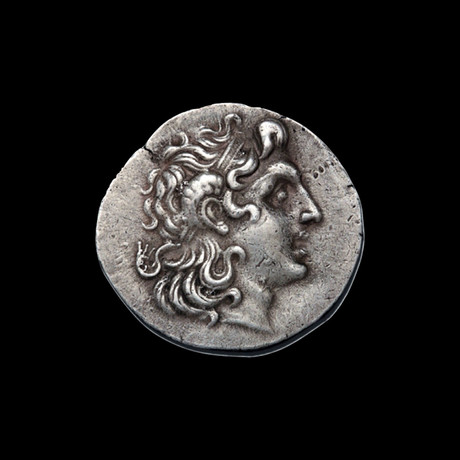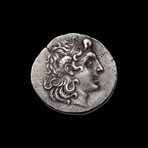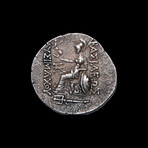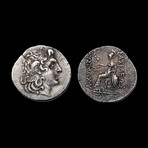Muzeion
Alexander the Great Lysimachos // 323-281 BCE Silver Tetradrachm Coin
Product Description
Following the untimely demise of Alexander the Great in 323 B.C.E., his generals, friends, and heirs engaged in forty years of wars over his empire. Lysimachus (r. 323– 281 B.C.E.), one of Alexander’s companions and bodyguards, used the king’s image on his own coins in order to cast himself in the role of successor and legitimize his claim to the kingdom of Thrace.
Alexander, responsible for establishing the conventions of royal portraiture, is depicted in his preferred manner: youthful and clean-shaven, with long locks of hair rising above his forehead and eyes cast heavenward. Additionally, he is shown with horns curling around his ears. These “horns of Ammon” symbolize Alexander’s claim that he was the son of the Egyptian god Ammon—a claim that was confirmed by the oracle at the sanctuary of the composite god Zeus-Ammon at Siwa, Egypt.
On the reverse of the coin Lysimachus exerts his own royal autonomy by naming himself “king.” The goddesses Athena and Nike (Victory) crown his name with laurels, which symbolized victory or honor. The shield at Athena’s side traditionally depicts a lion which references Lysimachus’s famous exploit of killing a lion with his bare hands and reinforces his association with Alexander, who used the skin of the Nemean lion as a symbol of power and courage.
Product Details
- ColorsSilver
- Materials
Silver
- Measurements
1.25"Diameter
— Circa 323-281 BCE
— Silver Tetradrachm
— Obverse: Diademed Head Of The Deified Alexander Right, With Horn Of Ammon
— Reverse: BaσIλeως Λyσimaxoy, Athena Seated Left, Holding Nike In Extended Right Hand, Left Arm Resting On Shield, Spear Behind And A Trident In Exergue
— Condition: Superb
Shipping Information
-
Shipping AvailabilityCanada, United States
-
Shipping PolicyStandard Ground Shipping
-
Ship In3-5 weeks ⓘ
-
Return PolicyFinal sale, not eligible for return or cancellation




















































 .
.